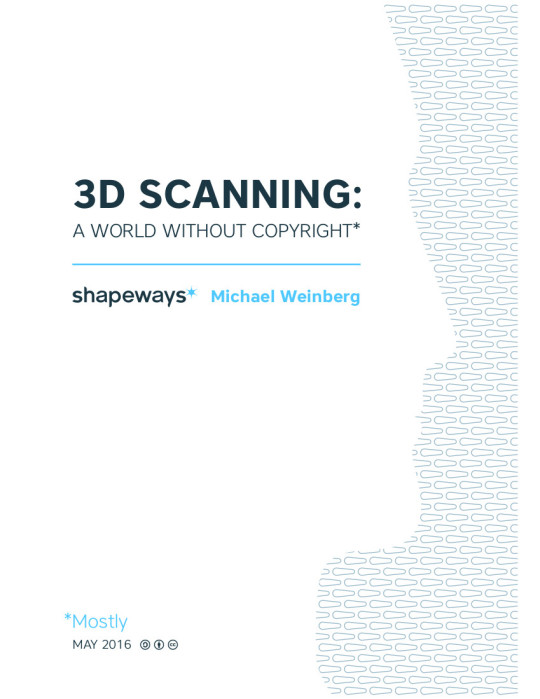
The version of this announcement that ran on the Shapeways blog is below. I just want to preface it with a huge thanks to my wife Jessica for doing all the real editing of this paper (as she does for all of the papers I write), Sherwin Siy for looking over this for me, Sophie Khan and Geoffrey Mann for letting me use their images to illustrate “non-representational” scans, Henrik Rydberg for designing the layout, Parker Higgins for inspiring footnote 11, and Shapeways (especially Marty Meyer) for letting me keep doing these papers. I also suggest quite strongly checking out Professor Margoni’s paper linked to below for an EU perspective and Paul and Laura’s forthcoming paper for a real law review article treatment of this stuff. I’ll add a link to it here once I have one that is not behind a paywall (if such a link exists). Also, Justin Hughes’ paper on photography and copyright is really great.
We are excited to announce a new whitepaper, 3D Scanning: A World Without Copyright*. As the name suggests, the paper examines how 3D scanning intersects with copyright law. We are big fans of 3D scanning here at Shapeways, and so we thought it was important to start a discussion around how copyright might impact all of the scans that are coming into the world.
It may come as a surprise, but in many cases 3D scans will not be protected by copyright. That does not mean that scans are not important, but it does mean that people making and distributing scans should understand what rights they do – and do not – have in those scans.
Why aren’t the scans protected by copyright? One of the key requirements for copyright in the United States is originality. Even if it takes a large amount of skill to create a scan, if making the scan does not involve originality it is simply not eligible for copyright protection.
The vast majority of scans fall squarely in that category. By definition, most 3D scans attempt to create a perfect digital replica of the model being scanned. Injecting “original” content that deviates from the object being scanned into that digital file would undermine the purpose of the scan.
Again, lacking originality does not mean lacking skill. Making accurate 3D scans can be hard work, and there is a real difference between someone who knows what they are doing and an amateur. But without room for creative interpretation, the resulting scan is not eligible for copyright protection.
Even without copyright, people making scans still have the ability to profit from and control their scans. Today many professional scanners charge for scanning services, and someone in possession of a scan file can charge someone else for access. This system seems to work; the ranks of professional scanners is swelling as 3D scanners become cheaper, better, and easier to use. These types of professional arrangements are strong because they are built on contracts which do not require copyright in order to be legally enforceable.
A lack of copyright on scan files will also make it easier for designers to access and build upon digitized works. It means that the person who scans a 2,000 year old Roman sculpture does not suddenly pull part of that sculpture out of the public domain. Once the sculpture is digitized anyone is free to print their own copies to have at home or in classrooms, increasing access to our collective digital heritage. Furthermore, those scans can be freely remixed into new interpretations of classic works. These scans can form the building blocks of all sorts of new creativity – new creativity that might itself be protected by copyright.
It is also important to recognize that just because most 3D scans are beyond the scope of copyright does not mean that all 3D scans will be. Scans that do intentionally inject original, creative elements such as Geoffrey Mann’s Shine and Sophie Kahn’s portraits are likely to be eligible for copyright protection. And, of course, 3D scanning is relatively new and the law around it could evolve right along with the technology.
Obviously we are going to keep our eye on this area of law and will do our best to update you as developments occur. If you are intrigued, I would encourage you to check out the new whitepaper here. For a more EU-centered take on 3D scanning and copyright (especially in the context of access to cultural heritage), try this paper by Professor Thomas Margoni. And, since our whitepaper is primarily written for a non-legal audience, if you are looking for a law review article that addresses many of these same issues keep your eyes peeled for an article by Paul Banwatt and Laura Robinson of Matter and Form in a forthcoming edition of the Intellectual Property Journal.